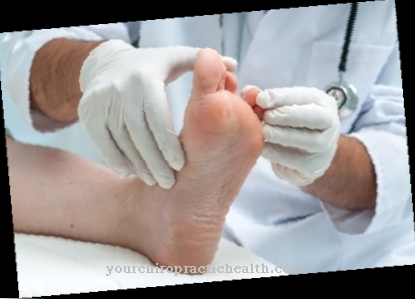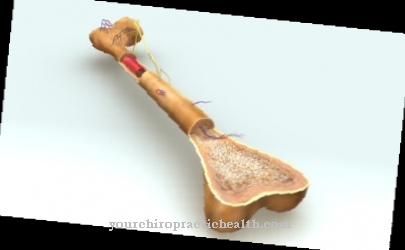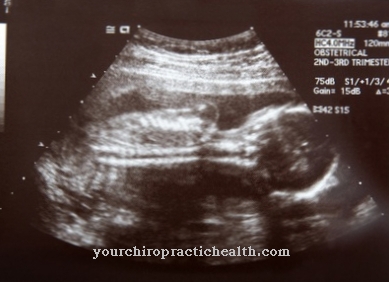Oxygen (O2) is essential for humans. The Oxygen uptake from the breath takes place in the lungs. From there, the oxygen-rich blood is transported to the cells. These need the oxygen as part of the inner cell respiration for energy production.
What is oxygen uptake?

With every inhalation, the breath flows through the nose, mouth and throat, the windpipe and the bronchi into the lungs. The so-called alveoli are located in the lungs. The alveoli are arranged like grapes. The human lungs are estimated to have 300 million alveoli. This is where the gas exchange and thus the oxygen uptake take place.
There are capillary vessels, i.e. small blood vessels, around every alveoli. The basis of the exchange of substances in the lungs is diffusion. Diffusion is a physical process that leads to a balanced mixture of two different substances. The blood vessels surrounding the alveoli are filled with oxygen-depleted blood, drawn from all over the body and pumped into the lungs by the right heart. After inhalation, there is a lot of oxygen in the alveoli. The oxygen moves from the place of high concentration, i.e. the alveoli, to the place with the lower concentration, the blood in the capillaries.
In connection with gases, diffusion is also known as partial pressures. Every gas exerts a partial pressure. The partial pressure describes the proportion that a gas has in the total pressure in a gas mixture. Different partial pressures now act in the lungs. There is a high partial pressure of oxygen in the lung alveoli, while the partial pressure of oxygen in the capillaries is rather low.
Thus, the oxygen passes into the pulmonary capillaries. This exchange creates an equilibrium between the O2 partial pressure in the alveoli and the O2 partial pressure in the surrounding vessels.
For carbon dioxide (CO2) there is a partial pressure difference in the opposite direction. The CO2 diffuses from the pulmonary capillaries into the alveoli and is then exhaled. In the blood, the oxygen binds to the hemoglobin of the red blood cells. The oxygen-rich blood then travels from the lungs to the left heart and is distributed throughout the body.
The partial pressure also plays a role in the oxygen uptake of the individual cells. The O2 partial pressure in the body's cells is lower than in the small blood vessels that supply the cells. Just like in the lungs, the oxygen now diffuses from the oxygen-rich blood into the oxygen-poor cells.
Function & task
Without oxygen, humans cannot exist, so that oxygen transport and oxygen uptake are vital. Oxygen itself does not contain any energy, but it creates the conditions for energy production in the body's cells. This process is also known as aerobic respiration or cellular respiration. It takes place in the mitochondria of the cell.
Mitochondria are cell organelles. Because of their function, they are also known as the power plants of the cell. To generate energy, the mitochondria need oxygen and glucose, i.e. sugar. Through various metabolic processes within the mitochondrial matrix, energy in the form of adenosine triphosphate (ATP) is obtained from sugar and oxygen.
Cell respiration takes place in four steps: glycolysis, oxidative decarboxylation, citric acid cycle and respiratory chain. Except for glycolysis, all processes require oxygen to run smoothly. ATP is a universal and, above all, direct energy carrier. It is estimated that every cell in the body uses 10 million ATP molecules every second.
By-products of cell respiration are water and carbon dioxide. About 32 ATP molecules can be obtained from one molecule of grape sugar under the influence of oxygen. Energy in the form of ATP can also be obtained under anaerobic conditions. However, lactate is produced there as a waste product. This can lead to symptoms of fatigue, especially in muscle tissue. In addition, the balance of 2 molecules of ATP per glucose molecule is rather bad.
You can find your medication here
➔ Medication for shortness of breath and lung problemsIllnesses & ailments
With chronic lung diseases, the oxygen uptake in the lungs is severely restricted. Pulmonary emphysema is often the result of chronic obstructive pulmonary disease (COPD). Due to the chronic obstruction of the airways, air remains in the alveoli when you exhale. This ultimately leads to overinflation of the alveoli. The dividing walls between the individual alveoli are destroyed and a large air space is formed within the lungs. Gas exchange can no longer take place here and oxygen uptake is accordingly prevented. Patients with emphysema suffer from shortness of breath and cyanosis, i.e. blue discoloration of the skin and mucous membranes.
If the functional lung tissue is converted into connective tissue, one speaks of pulmonary fibrosis. This can be caused, for example, by autoimmune diseases or exposure to asbestos.Connective tissue forms between the alveoli and the pulmonary capillaries. This hinders the uptake of oxygen. The symptoms of pulmonary fibrosis are shortness of breath, low resilience and constant coughing.
Severe lung diseases such as advanced fibrosis or advanced emphysema may require oxygen therapy to compensate for the oxygen deficit.
However, even with healthy lungs, normal inhalation and a normal oxygen content in the air, oxygen deficiency can occur. The cause here is a lack of absorption capacity of the red blood cells due to anemia. The oxygen reaches the blood from the alveoli but cannot bind to the red blood cells. The same applies to poisoning with carbon monoxide. The gas binds to the hemoglobin, blocking the space that the oxygen molecules would take up. Carbon monoxide poisoning can be fatal within a very short time.




.jpg)






















